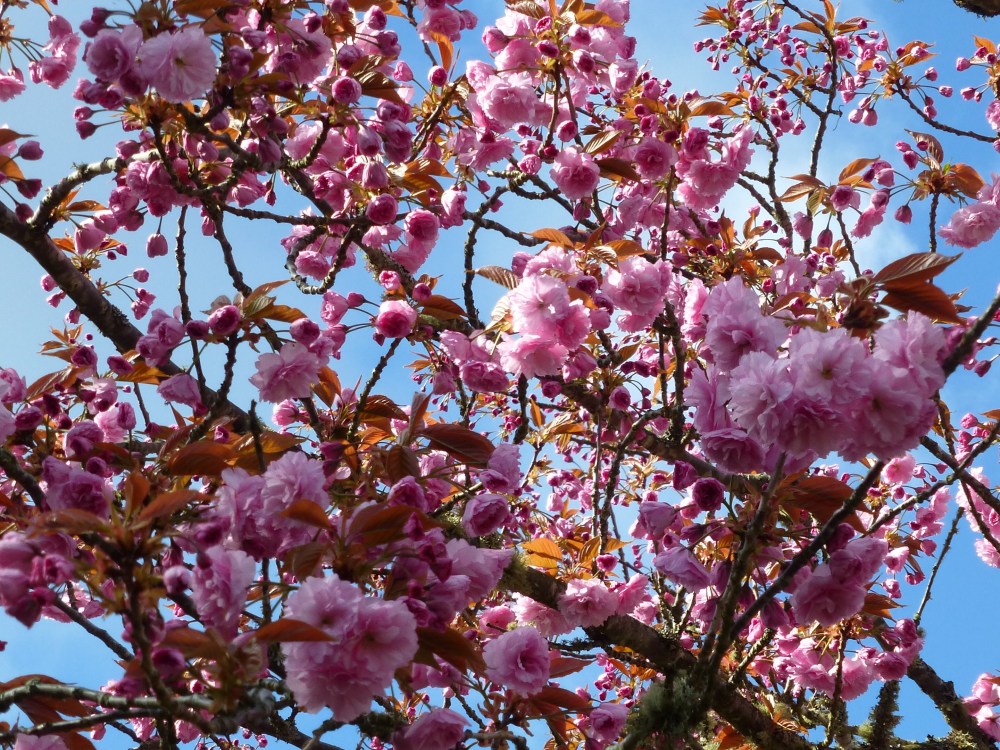What Folklore Does for Us
By Madronna Holden
(feel free to email me with comments, questions, or requests regarding this material at
holdenma@comcast.net)
- Folklore passes on the information and wisdom of human experience from generation to generation. In this sense folklore is the original and persistent technology that gave us human culture in the first place by allowing us to build on our experience over the generations. Oral tradition is the original form of education, in which both social values and environmental knowledge are transmitted.
Stories were so important in traditional Chehalis culture that children “paid” for them by doing tasks designed by their elders to challenge them into personal growth. One such task might consist of bringing back a stick from a distant and foreboding place at night; the distance this stick was placed from the child’s home village would increase with the confidence and personal development of the child.
These people said of their stories: “These will bring you to a place where you can take care of yourself,” and also, “These will tell you how to get along with one another.”
Traditional stories contained both psychological and environmental instructions for living the good life. Thelma Adamson, a researcher among the Chehalis in the 1920’s, remarks that she tried unsuccessfully for months to obtain material on dressing of elk skins, only to realize that one day she was getting this information in the midst of a story.
Mythologies of peoples all over native North America provided geographical maps of various native territories through the Culture Hero’s or Creator-figure’s journeys through those territories.
When pre-Civil War slaves coded their songs with geographical information for finding their way North to freedom, they were practising not only acute political savvy, but honoring the time-honored manner of passing such information on in their original African cultures. The folkloristic “maps” contained in traditional oral literature, in stories and songs and ceremonies of traditional peoples, often contain information about star position and rotation as well as earthly geographical information.
Among the Dogon (a people of Africa), their mythology contains detailed astronomical material that predicts the dates of appearance and re-appearance of stars from distant galaxies , which appearances they celebrate in ceremony. As early Euroamerican explorers noted, geological and even archaeological information was found in traditional oral literatures of the Pacific Northwest.
Detailed information on the nature and usages of local plants was also an integral part of folklore. William Irvin Thompson details how the well-known European tale of Rapunsel (remember “Rapunsel, Rapunsel, let down your hair”?) encoded both astronomical and herbal knowledge of European midwives accused of sorcery during the witch burning craze.
- Communities create and use folklore as a community-strengthening process, expressing and reweaving their sense of group cohesion. This was true of both the process of passing folklore on and the content of such folklore. The process for transmitting folklore was always an inter-personal one–and usually, as well, quite an occasion for entertainment. An audience to a story was not only given the content of the story to muse over, to take away with them until “it came time for them to use it,” they also had the shared experience of listening to that story.
In many African societies, a storyteller must be encouraged, with either traditional or spontaneous audience responses: the audience collectively works as a kind of “midwife” to a story as they share the experience of the story’s performance not only with the storyteller but with one another. African-American speeches today which are greeted with communal audience response are thus following in an ancient tradition. Indeed, audiences had special parts in a storytelling performance in every traditional culture I am aware of. The process of folklore transmission strengthened links between generations as well. In this process, the elderly gifted the young with knowledge and entertainment, and the young gifted the elderly with attention and respect.
There is, as a Chehalis woman directly expressed to Thelma Adamson in 1926, often a kind of “love” engendered in the process of sharing folklore. In speaking of a special medicinal knowledge that was the privileged domain of women in Chehalis society, she stated that the elder with knowledge of this special medicine would pass it on “to some young woman she loved.” I am often moved at the spontaneous outpouring of feeling of young children whenever I myself tell stories in their classroom. (I have worked with artist-in-residence programs as a storyteller in primary and secondary schools with two local arts councils.) Young children, especially, will rush up and hug me after a storytelling session. A classroom of seventh graders once wanted to know my age and then refused to believe it, since they had assumed me younger than their parents, as somehow part of their own generation, in the connection storytelling created between us.
The shared knowledge of the content of folklore strengthens community solidarity in may ways. Stories, practises, sayings, jokes, in common strengthens a family’s sense of themselves as a family. It was for this reason that a number of traditional peoples throughout the world (who were without our concept of material property) held that their stories were their real property. Among certain native peoples of the Northwest, only persons who belonged to particular families could tell the stories owned by those families. Spirit songs owned by particular individuals had subtle “markers” that indicated “where they were from” and should not be sung unless the singer had so carefully practised a song that its hearers could recognize these subtle markers and thus tell where the song “was from.” On an everyday level, we are all aware that sharing common knowledge with the members of a group gives us a special sense of membership in that group. Most professions in our society have their own “jargon” relating to their work, which outsiders are unlikely to know. Those who are familiar with the terms in this jargon, in turn, recognize one another as belonging to the same special group.
- Folklore functions as a kind of education for listening and a lesson in concentration for those who hear it. In societies where oral traditional predominates over written tradition, and a “word has power,” as Kiowa storyeller Scott Momaday puts. There is usually some very careful process of education for listening–and especially, for listening to differences, to voices other than one’s own.Stories from the time “when all the animals were people” prompt the listener to empathize with the way other creatures feel, see and respond to their world– how they have familiar cares to our own– and families like our own as well.
Traditional storytelling sessions were often exceedingly long. Among the Chehalis, they might go on for four night’s running. And all the while, children were expected to pay full attention to the proceedings. If they did not, they might be responsible for the loss of a story from their people’s tradition (as noted above). It was also stressed that the story was a gift that should not be treated lightly, but should be attended to with all one’s powers of concentration. After all, in stories were the very tools of survival.
Further, the very act of listening to stories, with their ability to totally engross the listener, is itself an experience in concentration, in listening to another with one’s whole being. Being engrossed in a story is an experience of attention and focus, which in turn readily transfers to other learning experiences. A teacher of first graders told me that her students did better at the math lesson that followed a particularly engrossing storytelling session than they had ever done before, as their total engrossment in the storytelling had spilled over into their other work.
- Folklore serves to develop a flexibility of thinking and a critical consciousness about events and choices of action. Because the information transmitted in folklore is not transmitted as a fact or a single answer, but is open to listener interpretation, it helps develop initiative and creative problem-solving skills in those to whom it is transmitted.
Folkloristic stories are full of surprises, of spontaneous turns of event; further, their symbolism is both open and exceedingly complex. By educating our children with such stories, we teach them the value of alternatives. We teach that there are many ways to approach a problem, and that a situation has many dimensions, some of them more apparent than others–and some of them, apparent only after additional experience in living. Thus a traditional Chehalis storyteller told me there was no one single interpretation for any story. Indeed, stories might appear mysterious to their listeners when they were told. But they planted seeds that would re-emerge at appropriate times in their listeners’ lives. As he put it, “We know what our stories mean when it comes time for us to use them”.
Whereas a child who learns by rigid formulas may feel stranded and helpless as historical and social situations change (which, of course, they always do), children who have been educated by folklore feel empowered by the sense of their traditional wisdom as a tool for their own use, to interpret and use as they see fit. Time and again, members of societies where oral tradition predominates have expressed to anthropologists their conviction that it is an affront to a child’s integrity to educate him or her with orders or “one right way” of doing things. To educate a child in this way rather than with stories is also considered not to be pragmatic. As a Navajo mother told Dorothy Lee, she must foster her child’s initiative and self-determination in the traditional Navajo manner of education, since she could neither control nor predict her child’s future experiences for it. (The Navajo educated their children by stories rather than precepts.) Incidentally, the New Testament follows this ancient idea in the communication by parable rather than direct answer to the questions posed by Jesus’ audiences.
With the conceptual flexibility of stories comes personal empowerment. Robert Bly quotes a conversation he had with a German therapist who worked in an institution for severely mentally ill individuals. This therapist took on a small experiment. Once a week he began to tell patients who wanted to hear them, fairy tales. All the therapists working in this institution counted their patients vastly improved on two counts after they had attended a number of storytelling sessions: These patients had new ways of conceiving of and expressing their distress, and they had a new and vital sense of alternatives to their situation–they felt that there was a way out of their illnesses. Interestingly, this therapist-storyteller also found that simply reading stories to the patients did not affect their treatment in the same way. He had to tell stories in order for the healing process of storytelling to work, in order, as Bly puts it, for the creative process to come through the storyteller and into the story.
- Folklore, and especially folklore as mythology, provides us with a sense of our place in the social and natural worlds, a sense of the meaning of our lives and actions. The quality of journey to which Paula Gunn Allen refers in describing myth is, in a very real sense, a journey of human spirit. In this way, mythology functions as a kind of spirit quest, as a guide in our search for ourselves and our human possibilities in our individual journeys through life.
A related concept Allen mentions is the idea of oral literature as integrative in function. Oral literature places nature and culture, action and thought, and ourselves and others (including other species and other times) in dialogue with one another. Mythology shows us a good deal about our meaning and power in this world by showing us our place. That place, in turn, can only be conceived in terms of its own setting within the web of life, in terms of our relationship to the life around us.
“I am alive,” Momaday says, expressing this view, “and therefore I stand in relation.” In its integrative function, mythology teaches us that to reach out to others and empathize with them is also to extend our own possibilities.
- As noted, folklore is that tool which originally gave us human culture by transmitting the collected wisdom of human experience between generations. In this sense, folklore also functions as what can be called a time-binding device. The transmission of information in folklore serves to link the generations within a society. But folklore has a much larger time-binding dimension as well. When we hear a story two thousand years old, we are re-living a two thousand year old history of the human psyche.
There are some things that distinguish folklore-as-history from the written history that predominates in our society today. Folklore is characteristically cast in a form that is readily accessible to all the members of the group to which it belongs–and it is classically framed, as well, in an experiential style.
The experiential style of folklore serves its educative function quite well. We have heard the often-quoted adage that those who do not remember history are condemned to repeat it. I would add, that to remember history as experience serves as the best guarantee against having to repeat it. We all know of cases where we understand a better choice, but nonetheless seem compelled to make the wrong one, to experience it, in order to learn some lesson for ourselves. Folklore provides its information as participation in the experience of situations and events. Indeed, members of cultures that rely predominantly on oral tradition understand its experiential presentation as a most important part of storytelling performance. A Chehalis woman told me that a good storyteller was the one who told a story “as if you were right there, seeing it happen.” Persons of all ages who want to express the power of particular stories they have heard have told me, “I was right there.” Being “right there,” in turn, allows us to rehearse particular experiences and to feel their consequences. As audience to a story, we have not only the knowledge, but the experience of human living beyond of our single lifetime.
- Folklore serves to entertain: It is just plain fun. Folklore shows us the delight that exists in the challenge of human living, and the wonder and mystery of our own possibilities in meeting that challenge. This last function of folklore may be in some ways its most important: for it is a function without which all the others would certainly be less effective.
With its delight, folklore entrances us into exploring our own creative possibilities and conceptual flexibility, and helps us attend to and retain the information it imparts to us. As entertainment, it best serves its function of binding together the members of a community; being fun is part and parcel of the sense, in many communities, of folklore as a gift from one generation to another. The humor and the entertainment in folklore also help us deal with personal and social crises in a way that gives us perspective on them without emotional distance: helps us to manage them, even while we also face, confront, and transform them.
- This point was added to my list by a man of Pit River (northern California) heritage who worked with troubled adolescents. He found that traditional stories foster the self-esteem of those who know them. Owning stories of this type gives one belonging and meaning, as well as the skills to engage one’s world in dialogue and the mental agility and personal presence that go with that. Scott Momaday once said, “I am the story of myself”; I would add that those who know their place in the larger story of their people know how to compose their lives as such a story.
Some of you might also have points of your own to add to this list.
Oral Tradition
“Get it in writing”, a modern saying warns us–implying that this is the only real and binding form of communication or contract.
Modern industrialized cultures separate folklore and oral tradition from the facts that we put into writing — the attitude Native people encountered when outsiders labeled their traditions as “just stories”. But as the list of the functions of folklore below indicates, the stories of oral tradition cannot be denigrated without losing an essential and critical tool with which to understand ourselves and our communities– and learn from our past.
Indeed, the attitude that puts down oral as opposed to written history has more to do with privilege in mainstream history-keeping than with the comparative quality of history-keeping in oral tradition. Modern industrial cultures tend to assert one “true” story: a “monotheism of story”, as James Hillman has put it.
Those in a position to write history decide what and how that history will be written. But this single story does not reflect the lives and perspectives of persons of all classes and cultures. “The winners write history. The rest of us just live it,” in the words of those I interviewed who kept oral history from the earliest pioneer times in the Pacific Northwest.
For a good part of Western European history very few people could write– in order to learn this skill, one had to have economic means not available to a large portion of the population.
Further, such history was written by the upper classes– the “winners”– so that the lives and perspectives of others who were not on top in this process were simply ignored, overlooked-and entirely devalued. Thus the statement that the winners write history–and that the history they write is distinctly separate from the lives of many who actually live that history.
See, for instance, Lies my Teacher Told Me for the ways in which such slanting takes place in modern school curriculum.
This is a very different manner of history-keeping from that of indigenous oral traditions, which is entirely more democratic. In oral tradition, ALL members of a culture pass on the traditions of that culture in a dynamic fashion. As Leslie Marmon Silko put it in Storyteller (from her ancestral Laguna Pueblo tradition), the story of a people was not complete unless and until it contained the stories of all members of a community.
Oral tradition is more fragile than something written down. As Kiowa writer Scott Momaday noted, oral tradition is always “one generation away from extinction”. But its fragility is also linked to its power: to the fact that it is passed on between people. As a Chehalis grandmother once told me, “Everything important around here is told person to person.”
Such oral history is verified by those who share the experiences it recounts.
I was struck by the personal vulnerability and critical openness of many who told their stories to me — offering critiques of their personal and social choices–as illustrated in another essay on this site. That is what oral tradition has always been about in the shaping of human cultures: passing on the wisdom learned by our elders– their mistakes as well as their successes.
Interestingly, even those from pioneer families used metaphors to express their oral histories when I spoke with them. There was the logger, for instance, who described the generations of his family’s experience on the land by three trees. These trees (he pointed out the surviving one to me) represented something larger about his family’s life than a bundle of facts. They created a bridge of metaphor (the original meaning of the word metaphor is to “carry across”) to deepen the story that linked their life cycles to that of the land.
Metaphor is an open-ended conceptual tool which allows us to see the world as linked and to enter the world of others. Metaphor, that is, tells us how something is like (or linked to) something else.
The metaphorical symbols in stories grow more and more profound as stories are passed on from generation to generation, so that a story that takes five minutes to tell may develop a dense symbolic resonance of meaning indeed–as I found in working with the African “dilemma tale,” “The Five Helpers”– whose symbols reflect both the archetypal hero’s journey–and the elements of the human decision-making process.
Unlike facts metaphors are not exclusive. When we state a fact, it is supposed to finish the matter, to be the last word. Thus we say, “When all is said and done, those are the facts”. But a metaphor doesn’t shut the door on anything. Because a family’s life resonates with three trees–as in one oral tradition I heard– that does not stop it from resonating with anything else.
Further material on folklore on this site:
The material above is taken from my lectures in folklore and mythology at Linfield College. Here are some other lectures from that class:
Lecture Three: Ancestors and Heroes
Lecture Four: Humor and Community; Tricksters and Human Freedom
Lecture Five: Archetypes and the Great Mother
Lecture Six: Men and Women
Lecture Seven: Sacred Geography: The Sense of Home
Lecture Eight: Ritual and Integration
.Here are some of my essays on folklore published in Parabola.
Go I Know not Where, Bring Back I Know not What
Wild Justice: Fairytales that Celebrate the Natural Order
Fierce Music: Recognizing the Real Enemy
Light who Loves her Sister Darkness: An Analysis of the Descent of Inanna
And here is a retelling of a powerful women’s tale from Eastern Europe:
And the ancient story of Inanna descent into the Underworld for the sake of her sister:
More Posts Relating to Oral Tradition
Here are some of the related posts and pages on this site (note that there are also stories sprinkled throughout all the essays here)
Takelma Siletz elder Agnes Baker Pilgrim: Honoring the Water
The story given to me by seals
“Dead bodies all the way down” (the need for honest oral tradition to guide us)
Nina Baumgartner’s story of the adoption of a pioneer baby girl by her grandmother
The material on this page is copyright 2008, Madronna Holden, all rights reserved. Feel free to link to this site and to contact me for permission if you wish to re-use anything here in print.








































People communicate through stories and these stories hand down knowledge, which includes both customs and traditions. It’s sad that because of our worldview of domination and dualism we would assume that our knowledge is good and theirs is bad. This viewpoint has allowed us to lose valuable information from the indigenous peoples that could help us in creating a sustainable environment.
Indeed, Liz. This mindset has also caused us to lose valuable information from our own ancestors–as in the pioneers who pointedly stated, “The winners write history. The rest of us just live it.” Seems like we can hardly afford to pass up the lessons that might come from those who actually lived the history we have inherited. Thanks for your comment.
The timing of my response to this essay comes at an incredibly opportune time. I have a son who is at an age where talking about past experiences, his future and life in general is of the utmost importance. He is still young enough to want to hear what I have to say but at the same time old enough to comprehend and form his own opinions. Each time I have shared a struggle, a triumph or anything about my past he has shown taken it to heart and tried to incorporate it into his life and his individual choices. I think because he knows who I am as a person; he is a stronger person because it helps him understand who he is.
Thanks for sharing your experience with your son in this respect, Anedra. You are following in an ancient human tradition in educating your son–and strengthening your relationship with him– through the sharing of stories. Passing on such experience through the generations is how we shaped human culture in the first place. And as a side note– given our current challenges, it is no time to neglect the process of sharing between generations and learning from our past now!
I believe oral tradition is an important concept. Some of the most inspirational words spoken to me in my life came from my late grandfather. At 98 years old, he had more wisdom on life than anyone I know. His life stories and experiences always turned out for the making of really good advice on any situation that arose. God Bless the old and wise and thank God for storytelling!
Thanks for sharing this bit of your grandfather with us, Amber. What a gift you obviously had in him-and he had in you as someone who appreciated what he had to share.
I think that oral tradition should be passed to the new generation by our grandparents. That is why I used to sit and talk with my grandmother every day when I was at home. But after moving here, I just call her whenever I have time. She has lots of perfect stories on how to deal with life difficulties. She loves the nature and thinks that the more time you sit in the sun, the more power you would have as you grew up. I try to memorize the stories and wisdom she tells so I can pass them to my children in the future. Finally, oral tradition is important from my perspective because the past is part of the future. Teaching new generations the traditions will give them a better idea on how to deal with life.
Thanks for sharing a bit of your grandmother’s spirit with us, Duaa. It is great that you are working to keep her stories. They are irreplaceable!
This made me think of a few things as I read. I just took a course in which we looked at the passing of knowledge and wisdom through stories. What I loved, and what written documents can not do, is that the stories told by an elder could be bent and modified to not only fit the circumstance, but also the individual who is being told the story. What an honor! You are no longer a sheep in a pack of those hearing (or reading)the same thing over and over. You are a special person to whom the story teller cares about in your ability to “get” the message, lesson, or humor.
My daughter has a very hard time with school, reading, and education in general. It is heartbreaking to watch her sink more and more into self soubt as she disconects from what she is reading out of frustration. However, this wonderful girl can repeat a song from the moment of hearing it! The story being told behind a musical song has a deep connection to her somewhere. She can relate to it on a personal level. To me this is the power of stories in music or otherwise. It brings us pleasure through entertainment, can bend to new traditions and generations, can teach us valuble lessons, and can bring people and communities together in wonderful ways.
Lovely point about being a special person as listener/receiver of oral tradition, Shawna. Obviously, your daughter has a learning style that does not fite with most modern day education. I am glad you are able to recognize that and support her, though it must be frustrating to see her problems with the mainstream school system.
Storytelling is an artform of a sort. I like how it is a teaching tool as well. It teaches indirectly and allows a person to tell another person about their behavior or choices without causing embarassment or defensiveness. The message may get through more easily and sink a bit deeper. Wisdom can be passed down in a more palatable way.
The other idea that intriged me was the idea that children would do chores to earn the telling of a story. I think it is a connection between generations, as the essay states: a link. I remember I loved listening to my grandparents tell stories. My older sister used to tell stories to me also. When my children were younger, we would go see story tellers whenever we had the chance. Even if the stories were hard for them to follow, there is something magical about hearing a story. It’s much different than having a story read to you. Now we have several folk tale CD’s that we listen to on long car rides, and at night, as they are falling asleep.
It’s interesting how stories were owned. I never thought of them that way, but it kind of makes sense when I think about it in terms of personal experience or lessons learned. Stories could be considered the history of a family, group of people, and an area/location. — Especially if the language does not have a writen form.
Reading this has made me want to come up with stories to tell my own children. I was trying to think of one story I was told as a little girl about the family or about anything, that wasn’t from a book, and I can’t. I don’t want that to be the case for my children.
Traditions for your family can begin with you, Michele. And sharing stories of your family’s own experiences can build closeness between all of you. And in the years I worked as a storyteller, I found that children love stories- so you have got everything going for you!
The tradtion of folklore is something that is missing from public education. Although it is getting better, it is interesting, especially with my second grader, to see what the district feels is important to teach the kids. I work for a ballet company that tours the northwest. One of the shows they are touring with right now is “Children of the Raven” which has a story teller to narrate the dancing. Children from the audience are brought up on stage to parttake in the action, allowing them to become part of the story. It is a very effective form of teaching. Locally, none of the school districts want to spend money on this educational performance, but out of town it is met with great success.
I grew up in a traditional Italian family and my grandparents used to tell me stories about there journey here to America. These stories enriched my life and taught me about my culture and the traditions of my family. I believe these stories are filled with wisdom that can be passed on from generation to generation. Unfortunately, it feels that kids today are far removed from the traditions of long ago and it is mostly due to how families spend their time. Long ago parents would sit around and tell thier kids stories and the know how of the generations before them. Today, however, kids spend most of their time watching TV or playing video games. Parents are spending less time interacting with their kids and are not engaging in activities such as storytelling. In our modern world with our new technology the traditions of long ago will be lost to our new generation.
How fortunate you are to have grown up in a family where stories surrounded you in this way, Elizabeth. When I told stories, I could tell kids who spent the most time in front of TV, since they had the shortest attention spans. There is nothing like a good story to engage kids–though it takes some practice/ experience in listening to learn to fully lose oneself in such listening. Thanks for your comment.
I agree with you here. In general it seems that families have gotten so busy to the point of interacting with each other on a dialy basis seems to be a thing of the past. When I was growing up everyone including grandparents ate dinner together every evening, talking sharing their day, sharing stories, sharing laughs. Today, I have a 19 year old son that I have hardly seen the past four years it seems. With work and school and sports and friends there is not much time for anything else. I actually find it sad that we as a society seem to have lost perspective on what is truly important, and that is each other and those around us.
Thanks for your response, Deborah. I think we cannot invent (or re-invent) too many things that allow us to share time, work, and values with our families and our communities. There is a difference between allowing our growing children the independence they need (even though we may miss them) and living lives fragmented from one another.
I find it sad but true about kids and parents spending less time interacting. Now-a-days spending time together means sitting in the same room texting other people, watching tv or playing video games. Oral inter-communication is becoming a way of the past.
When our little neighbor friend comes over she can’t get past the concept that we don’t have a tv. My kids are always playing games or make believe or anything but watching tv. The neighbor girl used to find it “boring” to be at our house but has come to enjoy the games and loves to hear the stories we have. She stopped asking about tv and has learned to be entertained by many other things but occassionally she goes home to watch tv when she gets tired of “thinking” as she tells us.
You have an important point, Ely. Oral traditions present the opportunity for generations to be truly present to one another. I have never felt more touched than when children pile up in my lap as a I began a story. They are showing me that they think of this as a gift.
Great job of educating you are doing for your children’s friends who need to get used to a home without a tv!
Delightful comment about resorting to tv when one “gets tired of thinking”– this child knows what is going on in her head. That cannot help but serve her well.
Oral storytelling has more personal and emotional value than written stories. I see the importance of writing things down- it is a good way to keep records of historical events, data, and research and so on but in no way does it take the place of the feeling and impact that oral storytelling has. Oral storytelling allows the listener to see the emotion and hear the emotion that the tale has on the teller. It is so much more memorable- I know that I tend to remember stories that are told to me rather than the ones that I’ve read because I can envision the person telling me the story and how they acted or what gestures they used.
I know that oral tradition changes as it gets passed on but that adds to the beauty of it. Each person adds a piece of themselves to the tale making it all that much more personal. I think that the personal essence that is lost in writing is what makes oral tradition so valuable. Anyone can read or write something down but it takes feeling and emotion and self to be able to tell a story.
My kids love to hear stories about our families past. They always ask to hear the same stories over and over even though they know them by heart. Sometimes I hear them telling each other the stories and I notice their little changes and personal additives which make it so special for them and for me because I know that someday they will tell the same stories to their kids.
Having been a storyteller for so many years, I have seen many times how much more “personal and emotional value” oral storytelling has over written stories.
Turning the pages of a picturebook for children to look at as you read to them may be a wonderful family pastime– but it is nothing to telling a story that a child can inhabit in his or her imagination.
The changes in such tradition help them respond to particular contexts. Wonderful point that “each person adds a bit of themselves as a story is passed down”.
How wonderful that you are sharing such family stories with your kids, Ely. There is a good reason why you have such sensitivity to the power of oral (and in this case, family) tradition.
[…] Holden, M. (2008). Our earth/ourselves. Retrieved from https://holdenma.wordpress.com/folklore-and-oral-tradition/ […]
In school we all learn “our” history; we learn the facts and what we are told to believe about these instances. However, I have always felt that there is something strongly missing in this form of education, that it was not relatable to my modern everyday life. Oral storytelling has the ability to be something more than education; it provides people with a sense of their own history.
One reason students disconnect in the classroom is that there is a banking system of education, that expects the students to take in information solely to spit it back out on a future exam. With folklore there is a sense of life lessons being taught. There is constant emotion being presented, a storyteller is providing a show. Children and people in general can relate to a story if it is told well. Morals and life lessons are easy to gather when they are taught through an experience and not rules.
I think it is amazing that people feel that they were in these stories or that these lessons were their own lessons. For me folklore provides a sense of identity, in the United States it seems more and more people are going through identity crisis. There lacks a sense of belonging in this country, when compared to others who have remained true to themselves through storytelling and cultural identity. If we know who and where we came from, there are less questions of how we came to be the people we are today.
You have a key point in contrasting education passed on through experience rather than rules– or memorization or “facts”, Odessa.
The former is giving children experience not only in the content of stories, but experience in thinking for themselves. Oral tradition is also, importantly, interpersonal– establishing the sense of belonging you point out we are too often missing in this society.
There is such intimacy in sharing our personal story with another–and such power in the gift of passing this on, if honestly and caringly done.
We are here because of the choices our ancestors made, just as our grandchildren will be located in the world according to the choices we are making.
And your use of the quote around “our” history also reminds us that oral history is shared history: indicating that we belong to a people and place.
very informative but how should I put the references if I want to quote some of the info?
Thanks for honoring the copyright here. You are welcome to link to this site. If you wish to cite something in a research paper or an online discussion note the web address and date accessed.
Here is the model used in another comment:
Holden, M. (2008). Our earth/ourselves. Retrieved from https://holdenma.wordpress.com/folklore-and-oral-tradition/
Как много тайн спрятано в истории земной цивилизации http://www.arheo-news.ru
Here is a link from NPR author, Mark Memmott, which brings to light the Supreme Court of Iceland’s contemporary environmental issue of building roads on sacred elf lands in 2013.
Thanks for sharing this, John– though I didn’t see the link. I should think this would be fascinating to read.
http://www.npr.org/blogs/thetwo-way/2013/12/24/256863444/highway-in-iceland-may-be-sidetracked-by-elves
There we go!
Thanks, John. Good to hear from you. Hope you are doing well.
A lot of what you’re saying here about folklore fits well with what I’m learning in Queer Theories class about theory, in particular theory expressed in poetry and narrative rather than in dry academicspeak. For instance:
Further, such history was written by the upper classes– the “winners”– so that the lives and perspectives of others who were not on top in this process were simply ignored, overlooked-and entirely devalued. Thus the statement that the winners write history–and that the history they write is distinctly separate from the lives of many who actually live that history.
Look at this quote from Aurora Levins Morales’s “The Historian as Curandera”, which we read for Queer Theories last week:
One of the first things a colonizing power or repressive regime does is to attack the sense of history of those they wish to dominate, by attempting to take over and control their relationships to their own past.
And for the most part it works, which is how we end up at the first quote above. But only for the most part. When pre-Civil War slaves coded their songs with geographical information for finding their way North to freedom, they were practising not only acute political savvy, but honoring the time-honored manner of passing such information on in their original African cultures. And After all, in stories were the very tools of survival.
I wish we as a culture had more respect for stories. We’re all sold on stories as entertainment and forget all the other purposes, even while (for example) stories as education do their work on us without our even noticing–representation in media is one of my pet causes, because Lt. Uhura in the original Star Trek should have been a black female character on TV outside the ‘maid/domestic help’ mold, not the first such character, and because every day the media spends telling everyone that (for example) black men are mostly criminals and trans people mostly don’t exist is another day or three everyone will believe exactly that.
Pointed connection on the takeover of history by the dominant classes in society– and the way that folklore can subvert this.
I wish we not only had more respect for stories, but more sophistication about the ways in which the culture manipulates and choosing story and then presents it as fact.
Elizabeth , your post was so intriguing, I went and read Morale’s paper. I loved the epigraph (I just learned that word!): “Until lions write books, history will always glorify the hunter. – South African proverb” . (One of the statements that my father would often say that I thought insightful was “The most important person at the meeting is the one who takes the minutes”–as he headed off to a some “association” meeting where he was secretary, lol)
There are a few (–okay, countless–) ideas that can overwhelm me: the most common is the size and complexity of the universe and another is the sheer amount of information being replicated and moved around on this planet. Consumption–like a horse eating grass–really is akin to burning a library as information is destroyed. Most information systems can recreate themselves (or be recreated) , like a Seattle library burning is not the same as the library of Alexandria being destroyed; and pulling up dandelions is not akin to cutting down yew trees because of the relative abundance of information that can replace the dandelions and the lack of replacement information that could replace a yew tree.
It isn’t just living systems. Even the clays are competing for crystal structure under our feet, and some clays win out over others and restructure all the adjacent clay. I suddenly think the world as nested Mandebrot fractals of information that imbinges or enhances the fractals around it and the normal boundaries no longer apply.
The transition back to humans and the consequences of information dynamics has real consequences to individuals and populations–even species — is jarring. . What is genocide, if not informational tyranny? War can be object based masquerading as political ideological warfare ( middle east over energy sources), but most war really is an attempt to take over writing the minutes of history.
To survive an ever-changing cultural landscape (that fills easily with cultural dandelions!) , sheer volume is important. It is so important to keep cultural diversity alive to replicate and disseminate ideas as prolifically as possible. Vandana Shiva seeks to do this with seeds–so that we are not unscrupulously reduced to a handful of genetically altered seeds that will create food security issues if left unchecked by its few genetic options. Indigenous cultures are trying desperately to do this everywhere with all parts of their culture.
In addition to “replicating” cultural dimensions, also is the ability to discover or create cross-cultural relevancy, so that the cultural strands can weave themselves into other cultures. Stories and songs are alone not the culture–memory of context is important (Like pocket full of posies and the plague) but it is a start.
Capturing, disseminating and creating cross cultural relevance I see as a valuable role (among many) of the Grandmothers. Grandma Aggie, who gives “voice for the voiceless.” Without her and the healer in the writing you mentioned, there will be several more trees that would fall in the forest without a sound. If a tree doesn’t make a sound, no one will hear it.
I guess the moral of all of these lessons, is to be noisy! In a value-adding, diverse kind of way.
Delightful conclusion– ” be noisy”– you came to as your wend your way through some fascinating ideas.
Perhaps fractals are an attempt to add the benefits of metaphor to mathematical descriptions of space– as crossing boundaries is what metaphor is all about. Of course, there are other ways to cross boundaries than with mathematical maps that “count” space one way or another. Whereas metaphor expands the dimensions of our thinking, “counting” diminishes three dimensional space. Here is a quote on Bruno Latour (sociologist who studies science) from Carolyn Merchant’s Ecological Revolutions, which notes the ways that we reduce “three-dimensional oceans, rivers, beaver, birds, rocks, and ores– to two-dimensional inscriptions– maps, charts, drawings, diagrams, lists, graphs, curves, equations, papers, texts, files, and archives”, making the former quantifiable and thus exchangeable one for the other in a laboratory. This has its uses– as long as we don’t take our reductions for the real thing–and remember the manipulations and choices we took on to get our calculations.
The thing about traditional stories is that they are held in the memory (and the bodies) of humans- and thus cannot be reduced in this way.
The destroying of natural libraries has special relevance to ecosystems that have come into balance with one another over thousands of years: there is an intimacy of knowing in this living together for so long, I think.
And then there is all important issue of destroying a cultural community through destruction of traditional knowledge– as the forced boarding school attendance for native children set out to do.
Thanks for your thought-provoking comment.
My daughter’s day caregiver is from a tribe with lands in Montana and spoke of these of those times you mention, that her family had had to endure. I was slow, I admit, to grasping the significance of something as deceptively innocuous as wearing shoes.
Stories are like that, aren’t they? Un-collapsible. In fact they are the exact opposite. they are like those children toys where you add water and they grow to many times their sized. (I know I have gotten a lot of metaphorical mileage out of stories I read as a child–but then I get a lot of mileage out of tv commercials–albeit old ones since I have not added many new ones in decades! )
There are indeed generations of vested meaning in many traditional stories– so that they have layers and layers of meaning– different for each audience they have– and often with yet more layers of meaning when they are retold.
am happy for reading all about our cultures
Thank you, Esbon!
dear madronna holden
thank you for the insights on folktales and their effect on us. may i please use the 8 effects you have listed in a paper i am presenting at seminar on ecofeminism and kannada folktales? the name of the folk tale is “A Flowering Tree” translated into english by A.K.Ramanujan which is in Wikipedia. kindly allow me to quote your ideas. thank you
parimal naik India
Dear Parimala,
You may certainly pass on these ideas in your paper. Thank you for your courtesy in asking and best of luck to you in your work.